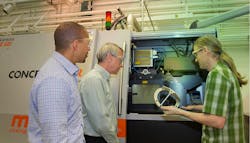LLNL researchers model physics of laser 3D metal printing (with video)
The powder-bed fusion process, also known as selective laser melting (SLM), is the most common method of metal 3D printing. Thin layers of a metal powder are spread across a build area, where they are fused by a laser or electron beam based on a 3D computer-aided design (CAD) model.
Physics-based modeling
Even though the method has quickly progressed into a production technology, 3D printing of metal parts (also known as metal additive manufacturing) for industries such as aerospace and health care is hampered, according to Wayne King, a researcher at Lawrence Livermore National Laboratory (LLNL; Livermore, CA), by a lack of confidence in the finished parts. This hurdle, he says, can be overcome by a combination of physics-based modeling and high-performance computing to determine the optimal parameters for building each part.
King and his colleagues at LLNL have created two physics-based models for the selective laser melting process on scales varying from the particulate powder to the whole part or component.1
The team’s comprehensive powder model addresses the formation, evolution, and solidification of the melt pool, and could be used to better understand how laser power, speed, beam size, and shape affect different types of metals and develop parameters for new materials, the researchers says. It also could provide insights into the dominant physical processes in the laser-powder interaction and guide improvements to the SLM method in the future, according to Andy Anderson.
The part-scale model simulates the 3D printing of full-scale parts, calculating the effects of stress and heat arising from a given type of metal and laser process parameters. It could improve predictions of deformation and stresses during printing that can lead to part failure, as well as help improve quality, eliminating much of the guesswork involved in creating new parts.
Building in compensations
“By modeling the fabrication you can see what is the aggregate behavior of the part and essentially build in compensations,” says Bob Ferencz, LLNL’s division leader for Computational Engineering. “If there is warping, we can warp the target geometry to arrive at the correct net shape. The benefit of simulations is that you can slow down the process and hopefully that informs you as to mitigations for the mechanisms you see as the cause of the failure.”
Combining the physics models with data-mining technologies and uncertainty analyses could optimize metal parts without the cost of multiple experiments, and aid in more widespread adoption of metal 3D printing, the researchers say.
Source: https://www.llnl.gov/news/researchers-outline-physics-metal-3d-printing
REFERENCE:
1. W. E. King et al., Applied Physics Reviews (2015); http://dx.doi.org/10.1063/1.4937809
About the Author
John Wallace
Senior Technical Editor (1998-2022)
John Wallace was with Laser Focus World for nearly 25 years, retiring in late June 2022. He obtained a bachelor's degree in mechanical engineering and physics at Rutgers University and a master's in optical engineering at the University of Rochester. Before becoming an editor, John worked as an engineer at RCA, Exxon, Eastman Kodak, and GCA Corporation.

